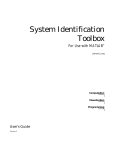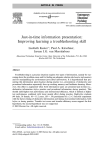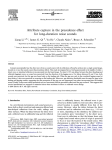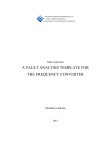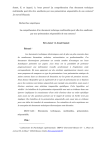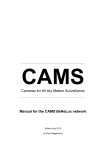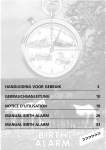Download Acquisition of troubleshooting skills in a computer
Transcript
Computers in Human Behavior Computers in Human Behavior 23 (2007) 1809–1819 www.elsevier.com/locate/comphumbeh Acquisition of troubleshooting skills in a computer simulation: Worked example vs. conventional problem solving instructional strategies A. Aubteen Darabi a a,* , David W. Nelson a, Srinivas Palanki b The Learning Systems Institute, Florida State University, 4600-C University Center, Tallahassee, FL 32306-2540, United States b College of Engineering, Florida State University, United States Available online 13 December 2005 Abstract In a computer-based simulation of a chemical processing plant, the differential effects of three instructional strategies for learning how to troubleshoot the plantÕs malfunctions were investigated. In an experiment concerning learnersÕ transfer performance and mental effort, the simulation presented the three strategies to three groups of learners and measured their performance on the transfer tasks. In this experiment, conventional problem solving was contrasted with two worked example strategies. The results indicated a significant difference between practicing problem solving and using worked examples. Learners who practiced problem solving in an interactive simulation outperformed the learners who studied computer-based worked examples. They also invested lower mental effort in transfer tasks. When accounting for the difference in the learnersÕ domain knowledge, the strategies were not significantly different among the more experienced learners. For the less experienced learners, those who practiced problem solving significantly outperformed their worked example counterparts. Among all participants and also among less experienced learners the problem solving group invested significantly lower mental effort in the performance of transfer tasks. Based on the results of this study, the authors recommend the use of the conventional problem solving strategy with or without worked examples for learning complex skills. Ó 2005 Elsevier Ltd. All rights reserved. Keywords: Simulation-based training; Computer-based training; Worked examples; Troubleshooting; Problem solving; Practice * Corresponding author. Fax: +850 644 4952. E-mail address: [email protected] (A.A. Darabi). 0747-5632/$ - see front matter Ó 2005 Elsevier Ltd. All rights reserved. doi:10.1016/j.chb.2005.11.001 1810 A.A. Darabi et al. / Computers in Human Behavior 23 (2007) 1809–1819 1. Acquisition of troubleshooting skills in a computer simulation: worked examples vs. conventional problem solving instructional strategies Cognition occurs in two contexts, internal and external. The internal context involves the preexisting knowledge that a person brings to tasks. The external context involves the physical or social environment that, together with the internal context, constitutes a framework in which cognition takes place (Ceci, Rosenblum, & DeBruyn, 1998). This framework provides the ‘‘cognitive apprenticeship’’ environment for practicing learning tasks in which learners can make their ‘‘thinking visible’’ (Brown, Collins, & Duguid, 1989; Collins, Brown, & Holum, 1991). A similar argument is the basis of PiagetÕs (1966) learning theory that describes the interaction of a learnerÕs existing schema, the internal context, with new information, the external context, by the process of accommodation. This process results in resolving dissonance between new information and the existing schema, which brings about learning (equilibration). In a complex learning environment, such as troubleshooting malfunctions of a chemical processing plant, the difficulty of the learning tasks stems from the complexity of integrating knowledge, skills, and attitudes, coordinating qualitatively different constituent skills, and using schema-based processes in solving a problem (Van Merrie¨nboer, Clark, & de Croock, 2002). Obviously, providing a real context for learners to practice these complex activities would not always be available or affordable. A computer simulation that offers the learners the opportunity for this integration and coordination provides the external context highly similar to a real-world framework. Given this argument, we programmed three instructional strategies in a computer simulation to provide learners with an authentic experience and investigate the impact of these strategies on learnersÕ performance. Conventional problem solving is one instructional strategy for acquisition and transfer of skills in a complex learning environment. Using this strategy, learners solve whole-task problems for the purpose of preparing to transfer their skills to a different problem situation (Van Merrie¨nboer, 1997). However, the strategy has been criticized by scholars interested in the relationship of cognitive load and instruction. Kalyuga, Chandler, Tuovinen, and Sweller (2001) argue that the conventional problem solving strategy can inhibit construction and automation of schemas for novice learners, and only benefits learners who have domain experience and thus existing schemas in that domain. According to Kalyuga, et al., novice learners rely on a means-ends strategy that imposes a heavy cognitive load when solving problems. Learners must ‘‘simultaneously consider the current problem state, the goal state, the differences between the current and goal states, the relevant operators and . . . any sub-goals that have been established’’ (p. 579). Another instructional strategy recommended for learning to solve complex problems is the use of worked examples (e.g., Kalyuga et al., 2001; Van Gog, Paas, & van Merrrie¨nboer, 2004), a strategy somewhat similar to direct instruction. Van Merrie¨nboer et al. (2002), Van Gog et al. (2004) identified ‘‘process-oriented’’ and ‘‘product-oriented’’ as two types of worked examples. Product-oriented worked examples describe the procedures involved in solving a problem by providing the learner with an initial state, a goal state, and a set of solution steps. Process-oriented worked examples, on the other hand, explain not only how to solve a given problem but also why the operations are employed. The worked example strategy has been found to be more effective than conventional problem solving for enhancing learner performance (Atkinson, Derry, Renkl, & Wor- A.A. Darabi et al. / Computers in Human Behavior 23 (2007) 1809–1819 1811 tham, 2000; Sweller, Van Merrie¨nboer, & Paas, 1998). According to the Cognitive Load Theory, novice learners in particular perform better when they use the worked examples strategy because their freed cognitive capacity can be used for schema construction and automation (Paas, Renkl, & Sweller, 2003, 2004; Sweller et al., 1998). However, this strategy can impose greater cognitive load on more experienced performers because of its interference with their existing schemas. Kalyuga, Ayres, Chandler, and Sweller (2003) have termed this phenomenon the expertise reversal effect. As Van Merrie¨nboer et al. (2002) argued, in solving a problem in a complex learning environment, the learners are required to integrate knowledge, skills, and attitudes, and coordinate qualitatively different constituent skills. We contend that worked examples, because of their descriptive nature, assist learners with the identification of task components and solution steps but not necessarily with the integration and coordination of constituent skills. When studying worked examples, learners may attend only to the surface features of a problem and not to the underlying principles that govern the operation of a system. Practicing actual problem solving, on the other hand, may assist learners in coordination and integration of the constituent skills required for performance and transfer of a complex skill. This coordination and integration may impose a higher cognitive load on learners practicing problem solving as an instructional strategy. However, because of this experience, learners may encounter a lower cognitive load during the performance or transfer of the same skills. Conversely, learners using worked examples as an instructional strategy may experience a lower cognitive load during instruction by substituting explanations of these processes for direct practice. But because of the lack of engagement in coordination and integration of constituent skills required for actual problem solving, these learners may experience a higher cognitive load during performance and transfer of their skills. Pairing of worked examples with related problems to be solved has been a common approach in examining the impact of worked examples (e.g., Carrol, 1994; Cooper & Sweller, 1987; Paas & van Merrrie¨nboer, 1994a; Sweller & Cooper, 1985; Zhu & Simon, 1987). That is, worked examples of complex problems have consistently been followed by practice at solving problems that are similar to the problems presented in the worked examples. We undertook to examine whether worked examples alone would be sufficient to result in greater performance of transfer tasks than the conventional problem solving strategy. We investigated the relative impact of two types of worked examples (process- and productoriented) and conventional problem solving strategies on the transfer performance of experienced and inexperienced participants in troubleshooting a computer-simulated chemical plant. Given the complexity of troubleshooting in this simulated learning environment, we tested the following hypotheses: 1. Among all of the participants, because of their active practice of coordination and integration of constituent skills provided by the simulation, learners using the conventional problem-solving strategy would: a. perform better in transfer tasks than learners studying either type of worked examples and b. experience lower cognitive load when performing transfer tasks. 2. Among the more experienced participants, because of the expertise reversal effect, those who used the simulated problem solving strategy would: 1812 A.A. Darabi et al. / Computers in Human Behavior 23 (2007) 1809–1819 a. exhibit better transfer performance than those who used either of the worked examples strategies and b. would invest less mental effort in performing transfer tasks than those who used the worked example strategies. 3. Among the less experienced learners, those who used either type of computer-based worked examples during instruction would: a. perform better in transfer tasks than those who used the problem solving strategy and b. invest lower mental effort than those who used the problem solving strategy. 2. Method 2.1. Participants Sixty-seven university students enrolled in engineering courses participated in the study as part of a required class assignment. They came from two different classes, one an introductory course in engineering and the other an advance design course in chemical engineering and had taken courses that included concepts of distillation. Participants were randomly assigned to three treatment groups using three different instructional strategies for the purpose of this experiment. The random assignment was conducted separately for each class to ensure the equal distribution of participantsÕ prior knowledge across the treatment groups. 2.2. Setting The experiment was conducted in the Complex Cognitive Skills Acquisition and Transfer Technology (CCSAT) Research Laboratory of the Learning Systems Institute (LSI) at Florida State University. Twenty-six workstations equipped with desktop computers running Windows 2000 or XP were loaded with PC-Distiller 1.0, a computer-based simulation of a water–alcohol distillation plant specifically designed for experiments in the acquisition and transfer of complex cognitive skills. 2.3. Instructional materials 2.3.1. Simulation The simulation software for this research, PC-Distiller 1.0, was designed and developed at LSI for use on Windows operating systems. This simulation is an advanced version of DISTILLER-I, a water-alcohol distillation simulation, that was developed by De Croock and Betlem (1999) for use on Macintosh computers. PC-Distiller (see Fig. 1) provides an authentic learning environment in which the participants play the role of the plant operator. As long as all sub-systems of the plant function normally, the operatorÕs role involves merely observing the automated operation of the plant. However, the gradual deterioration of the plantÕs components causes many types of malfunctions that the operator must diagnose and repair as quickly and as efficiently as possible. 2.3.2. General instruction Prior to operating the simulation all participants received the same initial computerbased instruction on how to operate the system. The goal of the instruction was to train A.A. Darabi et al. / Computers in Human Behavior 23 (2007) 1809–1819 1813 Fig. 1. Representation of the PC-Distiller overview screen. participants on the functions of the controls of the simulation and how to troubleshoot malfunctions of components in the plant. It consisted of computer-based text and graphics to teach participants about the components, features, and troubleshooting processes required to operate the simulation of the distillation plant. The text and graphics of this instruction presented the functions of the authentic simulation of a plant common in the chemical industry. The instruction first provided the participants with the requisite information about the systemÕs components and then allowed them to manipulate the simulationsÕ controls while it was not running. 2.3.3. Instructional strategies The instructional strategies used as three experimental treatments of this study consisted of two types of worked examples, process- and product-oriented, and conventional problemsolving. The process-oriented worked examples (PC) explained a procedure for analyzing each of four plant malfunctions and diagnosing the problem, including principled reasoning about why certain steps are taken and how the most likely cause of the malfunction can be identified using this principled reasoning. The product-oriented worked examples (PD) presented a procedure in five steps for solving each problem: (1) identify the affected regulating loop, (2) inspect preceding and following loops, (3) identify the components of the affected regulating loop, (4) examine each component in the loop – which involved three sub-steps that conclude with identifying the contradictory component as the cause of the malfunction – and (5) report the diagnosis. The conventional problem solving strategy (PB) consisted of practice at troubleshooting the same four malfunctions in the fully functional simulation without any of the supportive information that was presented to the worked example groups (PC and PD). 1814 A.A. Darabi et al. / Computers in Human Behavior 23 (2007) 1809–1819 2.4. Design and procedures All participants encountered three phases of the experiment: (a) instruction, (b) treatment, and (c) transfer performance. Instruction and treatment phases were completed in one session and the performance phase was completed 7–12 days later. ParticipantsÕ beginning and ending times for the instruction phase and performance phase were recorded. The two phases of the experiment are described below. 2.4.1. Instruction phase Each participant logged on to PC-Distiller. The log-on screen directed them to the general instruction and their randomly assigned treatment. All participants progressed through the same instruction at their individual pace until they came to the treatment phase. The instruction lasted about 1 h which was immediately followed by the treatment phase. Following the instruction, PC-Distiller guided participants to their assigned treatments as described below: 2.4.2. Process group (PC) Process group members were given four process-oriented worked examples in the treatment phase, each containing a particular component malfunction. The participantÕs task was to study text and graphics that explicitly describe and illustrate an approach to troubleshooting the malfunction using principle-based reasoning. Several graphic representations of the simulation interface, identical to those that an operator would encounter during the actual diagnosis of the malfunction, were provided as supported material throughout the worked examples. The approach explained in text and graphics not only how to solve the problem but also why the decisions are made and actions are taken. 2.4.3. Product group (PD) Participants in the Product group were given four product-oriented worked examples with the same malfunctions that were given to the Process group. The participantÕs task was to study the text and supportive graphics describing worked examples in a stepby-step heuristic procedure. However, in contrast to the Process treatment, these worked examples stated only how the problems are solved, but not the reasons why each step in the procedure was taken. 2.4.4. Problem group (PB) Participants in the Problem group engaged in practice with the fully functional simulation and were presented the identical malfunctions as those provided to the Process and Product groups. The Problem group members were asked to practice troubleshooting the problems without use of worked examples. Consistent with the conventional problem-solving approach, participants in the Problem group began to practice solving problems immediately after they received the initial instruction. 2.4.5. Transfer performance phase In the second session, all participants diagnosed an identical set of eight malfunctions in the fully functional simulation. The malfunctions involved components other than those encountered in the treatment phase. Participants were instructed orally and in written handouts to: (a) diagnose the malfunction as quickly as possible and (b) make as few incorrect A.A. Darabi et al. / Computers in Human Behavior 23 (2007) 1809–1819 1815 diagnoses as possible. Twelve minutes was allowed for each malfunction. PC-Distiller recorded the performance and mental effort data according to the measures listed below. 2.5. Instruments and measures 2.5.1. Transfer performance measures For the eight malfunctions presented during the transfer performance phase, PCDistiller recorded whether learners correctly diagnosed causes of the malfunctions within the time limit, the number of incorrect diagnoses, and the time participants took to correctly diagnose malfunctions. 2.5.2. Mental effort scale The 9-point Mental Effort Scale (Paas & van Merrrie¨nboer, 1994b) measured the subjectsÕ perceived mental effort invested in performing each of the troubleshooting tasks. At the high end of the scale, 9 was associated with the response ‘‘very, very high mental effort’’ and at the low end of the scale, 1 was associated with the response ‘‘very, very low mental effort.’’ PC-Distiller administered the scale immediately following each problem to provide a subjective rating of learner cognitive load for solving that problem. 3. Data analysis and results To test Hypothesis 1a, analysis of variance was used to analyze the transfer performance measured by the total number of correct diagnoses for all participants in the three instructional strategies. The omnibus test showed a significant difference among the three strategies (F = 5.22, df = (2, 64), p = 0.008). A planned contrast analysis was conducted to explore the difference between the conventional problem solving strategy (M = 7.32, SD = 0.78) and the worked example strategies (PC: M = 6.91, SD = 0.90; PD: M = 6.41, SD = 1.09). Assuming equal variance, the contrast analysis indicated that there was a significant difference (t = 2.70, df = 64, p < 0.01) between the PB and the worked examples strategies. To investigate the possibility of a difference between the two worked example conditions (PC and PD), they were contrasted against one another by holding the PB group constant. Again assuming equal variances, the difference between the two strategies was not significant with alpha set at the 0.05 level (t = 1.81, df = 64, p = 0.08). With regard to mental effort involved in performance of the transfer tasks, the exact same analysis was conducted to test Hypothesis 1b concerning the differences between conventional problem solving and worked example strategies. The omnibus test showed a significant difference among the three strategies (F = 5.25, df = (2, 64), p = 0.008). The participants using the PB strategy invested lower mental effort (M = 4.84, SD = 0.89) than their counterparts using worked examples (PC: M = 5.78, SD = 1.36; PD: M = 5.81, SD = 1.11). For the planned contrast analysis, assuming equal variance, there was a significant difference (t = 3.24, df = 64, p < 0.01) between the PB (M = 4.84, SD = 0.88) and the worked example strategies (PC: M = 5.78, SD = 1.36; PD: M = 5.81, SD = 1.11). The difference between the two worked example strategies (PC and PD) regarding the mental effort investment in transfer tasks was also investigated. The strategies were contrasted against one another by holding the PB strategy constant. Again assuming equal variances, the difference between the two strategies was not significant (t = 0.104, df = 64, p = 0.92). 1816 A.A. Darabi et al. / Computers in Human Behavior 23 (2007) 1809–1819 Hypotheses 2 and 3 were concerned with participantsÕ prior knowledge and the difference that it made in terms of their performance and mental effort in the transfer tasks across the instructional strategies. To test these hypotheses the participants were categorized into two groups of experienced and less experienced based on their prior coursework in engineering. Experienced participants were those who had several courses in engineering designing distillation plants. Less experienced participants were enrolled in their first engineering course. Analysis of variance was used to test Hypothesis 2a concerning experienced participantsÕ performance on the transfer tasks. The omnibus test indicated no significant difference among the instructional strategies for this group. Therefore Hypothesis 2a was not statistically supported to further justify the planned contrast analysis of the individual strategies. However, the performance score of the PB group (M = 7.17, SD = 0.84) was higher than either the PC (M = 6.92, SD = 1.00) or the PD (M = 6.75, SD = 0.97) groups. Neither were the instructional strategies significantly different with regard to these participantsÕ mental effort invested during the transfer performance tasks (Hypothesis 2b). The same analysis revealed that all three groups invested approximately the same amount of mental effort. The results were M = 5.05, SD = 0.86 for the PB group, M = 5.54, SD = 1.40 for the PC group, and M = 5.85, SD = 1.11 for the PD group. For the less experienced participants, however, the analysis of variance revealed different results for both parts of Hypothesis 3. Regarding their performance (Hypothesis 3a) on the transfer tasks (PB: M = 7.50, SD = 0.71; PC: M = 6.91, SD = 0.83; PD: M = 6.00, SD = 1.15), the omnibus test indicated that the three strategies were significantly different (F = 6.84, df = (2, 28) p = 0.004). The planned contrast analysis also found that the PB strategy was significantly different from the worked example strategies (t = 2.98, df = 28, p < 0.01). In a subsequent contrast analysis, the two worked example strategies also were found to be significantly different from one another among the less experienced participants (t = 2.28, df = 28, p = 0.03). The same analysis was conducted to test Hypothesis 3b concerning participants investment of mental effort on the transfer tasks. The analysis of variance revealed a significant difference (F = 4.68, df = (2, 28), p = 0.02) between the PB strategy group, which invested a lower mental effort (M = 4.58, SD = 0.87) in transfer performance than the worked example groups (PC: M = 6.03, SD = 1.34; PD: M = 5.76, SD = 1.17). For easy reference, the descriptive statistics presented in this section are displayed in Table 1. 4. Discussion This study focused on the learnersÕ transfer performance after the practice of conventional problem solving or the use of worked examples as instructional strategies. We first investigated the overall impact of these strategies on learnersÕ transfer performance and the mental effort they invested in that performance regardless of their domain knowledge (Hypothesis 1). The superior transfer performance of participants who practiced problem solving supported our first hypothesis. The finding provided evidence that, regarding complex problem solving requiring heuristic techniques, the use of worked examples not followed by practice is an insufficient instructional strategy. The results also showed that, with this studyÕs participants, the two types of worked examples were not significantly different from one another in regard to the learnersÕ transfer performance. A.A. Darabi et al. / Computers in Human Behavior 23 (2007) 1809–1819 1817 Table 1 Descriptive statistics for transfer performance and invested mental effort by experience level and instructional strategy Transfer performance Mental effort n M SD Minimum Maximum n M SD Minimum Maximum All participants PB PC PD 67 22 23 22 6.88 7.32 6.91 6.41 0.99 0.78 0.90 1.09 4 6 5 4 8 8 8 8 67 22 23 22 5.48 4.84 5.78 5.81 1.21 0.89 1.36 1.11 2.75 3.25 2.75 3.63 8.38 6.25 8.38 8.00 More experienced PB PC PD 36 12 12 12 6.94 7.17 6.92 6.75 0.92 0.84 1.00 0.97 5 6 5 5 8 8 8 8 36 12 12 12 5.48 5.05 5.54 5.85 1.16 0.86 1.40 1.11 2.75 3.63 2.75 4.38 8.00 6.25 7.00 8.00 Less experienced PB PC PD 31 10 11 10 6.81 7.50 6.91 6.00 1.08 0.71 0.83 1.15 4 6 6 4 8 8 8 8 31 10 11 10 5.48 4.58 6.03 5.76 1.28 0.87 1.34 1.17 3.25 3.25 4.00 3.63 8.38 5.75 8.38 7.13 Note. PB, conventional problem solving; PC, process oriented worked examples; PD, product-oriented worked examples. We found similar group differences concerning participantsÕ invested mental effort in performance of the transfer tasks. Learners who used problem solving as their instructional strategy invested lower mental effort during transfer tasks than those who used the two worked example strategies. The worked example groups, however, did not differ from one another in their investment of mental effort. These findings indicated that practicing problem solving during instruction is more effective than using worked examples. As proposed by Van Merrie¨nboer, Kirschner, and Kester (2003), practicing problem solving should serve to automate recurrent aspects of a complex task, thus preventing cognitive overload and freeing the learnerÕs limited working memory for attending to non-recurrent aspects of the task. The superiority of practicing problem solving found in this study is consistent with this proposal and may explain the lower investment of mental effort by the problem solving group in performance of the transfer tasks. This significance of practicing problem solving may be the reason why van Merrie¨nboer, et al. concluded that worked examples of a given task class should eventually be followed by conventional problem solving. The advantage of practicing problem solving that we found in terms of performance and mental effort was further examined in relation to participantsÕ domain knowledge. Among the more experienced learners, the data did not support our second hypothesis. There was no statistically significant difference among the strategies for these learners relative to their performance or mental effort. However, there was a trend toward the advantage of the problem solving strategy over the other two. Even though not statistically significant, this trend is consistent with the expertise reversal effect (Kalyuga et al., 2003, 2001). The more experienced participants in the problem solving group demonstrated an advantage over the other two groups by their higher performance and lower investment of mental effort as predicted by this effect. In the case of less experienced learners, the subjects of our third hypothesis, the differences among the instructional strategies were more evident. Additionally, participants in the problem solving group performed better and invested less mental effort in their performance than 1818 A.A. Darabi et al. / Computers in Human Behavior 23 (2007) 1809–1819 their worked example counterparts. This was contrary to what we expected according to the hypothesis. It was also contrary to the notion of the expertise reversal effect that suggests, among the less experienced subjects, the worked example strategies should have shown more positive results in terms of performance and mental effort. Moreover, the difference between the two types of worked examples was also found to be significant for these participants. The process-oriented strategy group demonstrated better performance than their productoriented strategy counterparts. This finding was consistent with what Van Gog et al. (2004) suggested for the use of process-oriented worked examples. Nevertheless, the problem solving group had the highest performance and the lowest mental effort, both of which differences were statistically significant (see Table 1). An explanation of this contradictory finding may be that the introductory information for operating the simulation, in relationship with the subjectsÕ prior knowledge of complex systems, instantiated schemas that later conflicted with learnersÕ interpretations of the worked examples. Or, as Van Merrie¨nboer et al. (2003) argue, studying worked examples unaccompanied by practice of complex cognitive tasks, regardless of the learnerÕs skill level, is not sufficient to develop a robust schema that results in relatively easy, positive transfer performance. These findings indicated an overall superiority of practicing problem solving relative to performance and mental effort involved in transfer tasks given either high or low domain knowledge. Studying worked examples without any practice tasks, one may argue, is a cognitive activity that may conflict with the learnerÕs existing schema. On the other hand, the practice of authentic tasks in a situated learning environment is a necessary ingredient to the integration of learnersÕ internal and external contexts. According to these results, worked examples alone are not sufficient instructional strategies for learning complex cognitive skills. Designing instruction for these skills should certainly involve practicing conventional problem solving with or without worked examples. Further research in this area could employ verbal protocol analysis (Ericsson & Simon, 1997) to investigate and explain further reasons behind these issues. Acknowledgements Eric Sikorski, Kolavenno Panini, and Ying Zhang assisted in the collection and analysis of data. Jyothy Vemuri assisted in the development of instruction and the management of participants. Kolavenno Panini, Jyothy Vemuri, Jeffrey Sievert, Robin Donaldson, and Steven Hornback, assisted in the formative evaluation of the instructional program. References Atkinson, R. K., Derry, S. J., Renkl, A., & Wortham, D. (2000). Learning from examples: instructional principles from the worked examples research. Review of Educational Research, 70, 181–214. Brown, J. S., Collins, A., & Duguid, P. (1989). Situated cognition and the culture of learning. Educational Researcher, 18(1), 32–42. Carrol, W. (1994). Using worked examples as an instructional support in the algebra classroom. Journal of Educational Psychology, 86, 360–367. Ceci, S. J., Rosenblum, T. B., & DeBruyn, E. (1998). Laboratory versus field approaches to cognition. In R. J. Sternberg (Ed.), The nature of cognition (pp. 385–408). Cambridge, MA: MIT Press. Collins, A., Brown, S. B., & Holum, A. (1991). Cognitive apprenticeship: making thinking visible. American Educator, 15(3), 4–46. A.A. Darabi et al. / Computers in Human Behavior 23 (2007) 1809–1819 1819 Cooper, G., & Sweller, J. (1987). The effects of schema acquisition and rule automation on mathematical problem-solving transfer. Journal of Educational Psychology, 79, 347–362. De Croock, M. B. M., & Betlem, B. (1999). DISTILLER: A computer simulation of a water/alcohol distillery system for research and training for transfer of supervisory control and troubleshooting skill. In M. B. M. De Croock (Ed.), The transfer paradox: Training design for troubleshooting skills (pp. 59–87). Enschede, The Netherlands: Print Partners Ipskamp. Ericsson, K. A., & Simon, H. A. (1997). Verbal protocol analysis; Verbal reports as data (Rev. ed.). Cambridge, MA: MIT Press. Kalyuga, S., Ayres, P., Chandler, P., & Sweller, J. (2003). The expertise reversal effect. Educational Psychologist, 38(1), 23–31. Kalyuga, S., Chandler, P., Tuovinen, J., & Sweller, J. (2001). When problem solving is superior to studying worked examples. Journal of Educational Psychology, 93(3), 579–588. Paas, F., Renkl, A., & Sweller, J. (2003). Cognitive load theory and instructional design: recent developments. Educational Psychologist, 38, 1–4. Paas, F., Renkl, A., & Sweller, J. (2004). Cognitive load theory: instructional implications of the interaction between information structures and cognitive architecture. Instructional Science, 32, 1–8. Paas, F., & van Merrrie¨nboer, J. J. G. (1994a). Variability of worked examples and transfer of geometrical problem-solving skills: a cognitive load approach. Journal of Educational Psychology, 86, 122–133. Paas, F., & van Merrrie¨nboer, J. J. G. (1994b). Measurement of cognitive load in instructional research. Perceptual and Motor Skills, 79(1, part 2), 419–430. Piaget, J. (1966). Psychology of intelligence. Totowa, NJ: Littlefield and Adams. Sweller, J., & Cooper, G. A. (1985). The use of worked examples as a substitute for problem solving in learning algebra. Cognition and Instruction, 2, 58–89. Sweller, J., Van Merrie¨nboer, J. J. G., & Paas, F. G. W. C. (1998). Cognitive architecture and instructional design. Educational Psychology Review, 10(3), 251–296. Van Gog, T., Paas, F., & van Merrrie¨nboer, J. J. G. (2004). Process-oriented worked examples: improving transfer performance through enhanced understanding. Instructional Science, 32(1–2), 83–98. Van Merrie¨nboer, J. J. G. (1997). Training complex cognitive skills: A four-component instructional design model for technical training. Englewood Cliffs, NJ: Educational Technology Publications. Van Merrie¨nboer, J. J. G., Clark, R., & de Croock, M. B. M. (2002). Blueprints for complex learning: The 4C/IDModel. Educational Technology Research and Development, 50(2), 39–64. Van Merrie¨nboer, J. J. G., Kirschner, P. A., & Kester, L. (2003). Taking the load off a learnerÕs mind: instructional design for complex learning. Educational Psychologist, 38(1), 5–13. Zhu, X., & Simon, H. (1987). Learning mathematics from examples and by doing. Cognition and Instruction, 4, 137–166.











